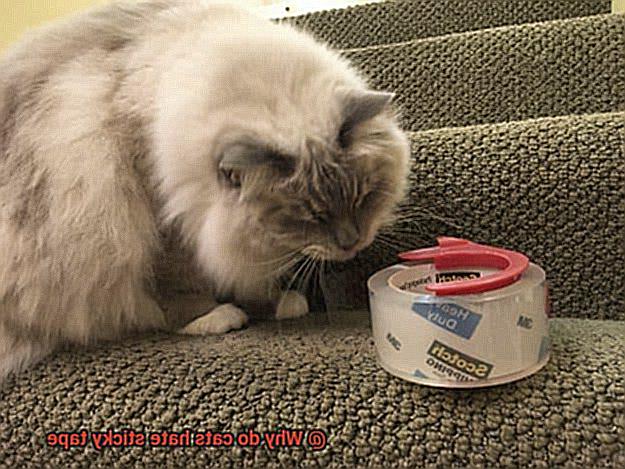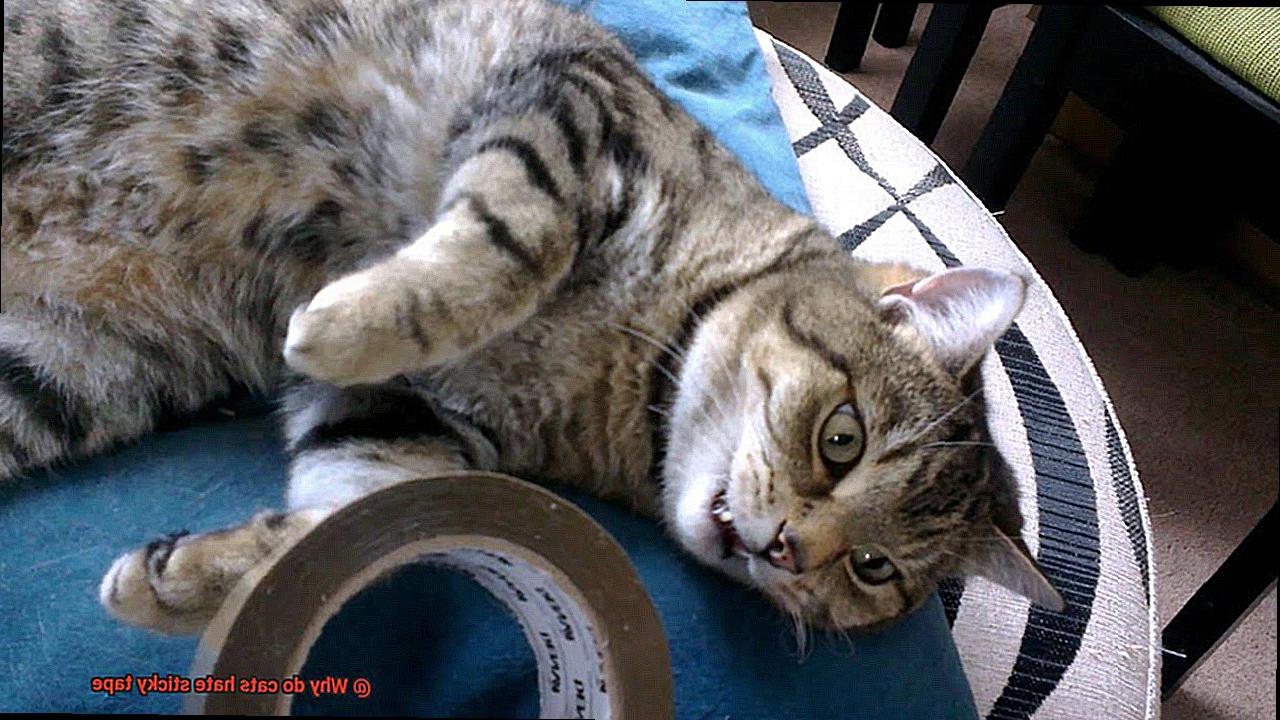Do you know that feeling when you’re trying to wrap a gift or package with scotch tape, and your cat comes swatting at it or running away like a bat out of hell? It’s a common scenario among cat owners. Sticky tape seems to be one of the most despised things by our feline friends. But what exactly makes them hate it so much?
Some people believe that cats dislike the texture of tape, while others think they don’t like the sound it makes when peeled off the roll. However, none of these explanations can fully account for the range of behaviors observed in cats around sticky tape.
Recent scientific studies have uncovered the real reason behind this peculiar behavior: cats’ highly sensitive sense of smell. Cats have an exceptional sense of smell compared to humans and can detect scents that we cannot. When they come across sticky tape, they pick up on a scent associated with danger or distress.
So next time your cat goes bonkers over some tape, remember that they’re not just being silly. They’re sniffing out something that has them worried, and as their owner, it’s our responsibility to help them feel secure and safe.
Sensitive Paws Theory
Well, the sensitive paws theory may provide some answers.
Cats have incredibly sensitive paws that they rely on to navigate their surroundings. Their paw pads are covered in tiny sensory receptors called mechanoreceptors, which allow them to detect changes in pressure, texture, and temperature. When a cat steps on something sticky, these receptors send signals to the brain that indicate discomfort or pain.
The sensation of sticky tape sticking to their fur is not only uncomfortable but can also be downright painful for cats. The tape pulling on their fur can cause discomfort and make them avoid it at all costs. Sticky substances can also trigger anxiety or fear in cats, making them feel trapped and unable to move freely.
Although not all cats react the same way to sticky tape, the sensitive paws theory provides a compelling explanation for why many cats seem to dislike it so much. Some may be more sensitive than others, while some may simply find it annoying.
As cat owners, we may use sticky tape as a tool to discourage unwanted behaviors such as scratching furniture or climbing on counters. However, we need to use it responsibly and never use it in a way that could harm our furry friends.
Sound Aversion Theory
The Sound Aversion Theory provides a compelling explanation for this seemingly odd aversion.
The theory suggests that cats have an acute sense of hearing, allowing them to perceive sounds that we humans simply cannot. The sound of sticky tape being pulled off a surface falls within this range of unpleasant sounds for cats. This can cause them to associate the sound with negative experiences, leading to their aversion to sticky tape.
But it’s not just the sound that’s upsetting for cats – the texture of the tape itself can also be a contributing factor. The sticky and adhesive nature of the tape can feel uncomfortable on their sensitive paws and fur, making it all the more unpleasant.
So what can you do if you need to use sticky tape around your feline friend? One option is to avoid using it altogether and opt for alternative ways to keep your home tidy. From furniture covers to scratching posts, there are plenty of alternatives that won’t cause distress for your cat. If you must use tape, try using a different type that produces less noise or has a less sticky texture.

Fear of the Unknown Theory

The Fear of the Unknown Theory provides a compelling explanation for this common feline behavior. Cats are naturally cautious animals and are intimidated by unfamiliar objects or stimuli, like sticky tape with its unusual texture and adhesive properties.
It’s not just a matter of novelty either. Cats are instinctually wary of unfamiliar environments and objects, taking their time exploring new things. Sticky tape can trigger their fear response, making them feel threatened and prompting them to avoid it altogether.
Furthermore, cats are known for their sensitive paws and are very particular about what they step on or touch. Sticky tape can be particularly unpleasant for them as it sticks to their paws and fur, making them feel trapped and uncomfortable. This discomfort can reinforce their fear of the tape, making them avoid it even more in the future.
Solutions for Pet Owners
Sticky tape may seem like a quick fix, but as we’ve already established, cats have an aversion to sticky surfaces. So, what are some alternative solutions for pet owners?
One solution is investing in a high-quality scratching post. Cats have a natural need to scratch to maintain their claws and stretch their muscles. By providing them with a designated area to scratch, you can redirect their energy away from your furniture. Make sure the post is tall enough for your cat to fully extend their body and choose a material that mimics the texture of the items they typically scratch.
Another solution is using deterrent sprays specifically designed for cats. These sprays contain natural scents that cats find unpleasant, such as citrus or lavender. Simply spray the deterrent on the areas you want to protect and your cat should avoid them.
In addition to these solutions, providing your cat with plenty of toys and playtime can help redirect their energy away from destructive behavior. Interactive toys that mimic hunting behaviors, such as feather wands or laser pointers, can be particularly effective.
If all else fails, consider consulting with a veterinarian or animal behaviorist. They can provide personalized advice and strategies for managing your cat’s scratching behavior.
Benefits of Sticky Tape
Sticky tape, also known as adhesive tape, is a simple yet essential household item that we often take for granted. Its uses are numerous, from wrapping gifts to sealing packages and repairing torn papers. However, beyond its basic functions, sticky tape has many other surprising benefits that can make your life a whole lot easier.
One of the primary advantages of sticky tape is its ability to be easily removed without leaving any residue or damage. This makes it an excellent alternative to nails and screws when it comes to decorating or organizing your home. Whether you want to hang pictures or posters on your walls, stick up a reminder note in your office cubicle, or create a temporary display for a party, sticky tape can do the job without damaging your surfaces.
Sticky tape is also a fantastic cleaning tool. It can be used to remove pet hair, lint, and dust from clothing and furniture with ease. All you need to do is wrap a piece of tape around your hand with the sticky side facing outwards and gently press it onto the surface you want to clean. The dirt and debris will stick to the tape, leaving your surfaces clean and free of unwanted particles.
Another significant benefit of sticky tape is its versatility. With different types of adhesive tapes available in various sizes and strengths, you can use it for a wide range of tasks. From fixing broken toys to holding together a broken pair of glasses temporarily, there’s always a type of sticky tape that can do the job. Plus, it’s easy to find at any store and won’t break the bank.
Potential Risks of Sticky Tape
One of the most significant dangers of using sticky tape around cats is that it can easily get tangled up in their fur, causing discomfort and skin irritation. In severe cases, the tape may need to be removed by cutting it out of the cat’s fur, which can be a traumatic experience for both the cat and its owner.
Another risk that cats face is ingesting small pieces of sticky tape. While trying to remove the tape from their fur or paws, they might end up swallowing it. This can cause digestive issues such as vomiting and diarrhea, which may require medical attention. If the tape contains any toxic substances or adhesives, ingesting it could be even more hazardous for cats.
Besides physical risks, sticky tape can also lead to psychological stress for cats. Some felines become extremely anxious or agitated when they come into contact with sticky tape, which can cause behavioral issues such as aggression or avoidance. This is particularly true for cats who have had negative experiences with sticky tape in the past.
Therefore, if you must use sticky tape around your cat, it’s crucial to take necessary precautions. Keep the tape out of reach of your cat and dispose of it safely once you’re done using it. If possible, avoid using sticky tape altogether and opt for other alternatives.
Conclusion
To wrap up, it’s clear that cats’ aversion to sticky tape is rooted in their biology and sensory perception. Their keen sense of smell and sensitive paws make them wary of anything that could potentially harm them. The sound and texture of the tape only add to their discomfort.
As pet owners, it’s important to be mindful of our feline friends’ needs and preferences. Instead of relying on sticky tape to deter unwanted behavior, we can provide alternative outlets for their natural scratching instincts. Investing in high-quality scratching posts, interactive toys, and deterrent sprays can redirect their energy in a positive way.
If you’re struggling with your cat’s scratching behavior, seeking advice from a veterinarian or animal behaviorist can be incredibly helpful. They can provide personalized strategies for managing your cat’s behavior and ensuring they’re happy and healthy.
While sticky tape may seem like a convenient household item, it’s essential to use it with caution around our pets. It can cause skin irritation if stuck to their fur or paws and lead to digestive issues if ingested. Proper disposal is also crucial to avoid any potential hazards.
In short, understanding why cats dislike sticky tape can help us create a safe and comfortable environment for our furry companions while still maintaining a functional household.







